ECU CHEVROLET CORVETTE 1998 5.G Owners Manual
[x] Cancel search | Manufacturer: CHEVROLET, Model Year: 1998, Model line: CORVETTE, Model: CHEVROLET CORVETTE 1998 5.GPages: 378, PDF Size: 19.91 MB
Page 27 of 378
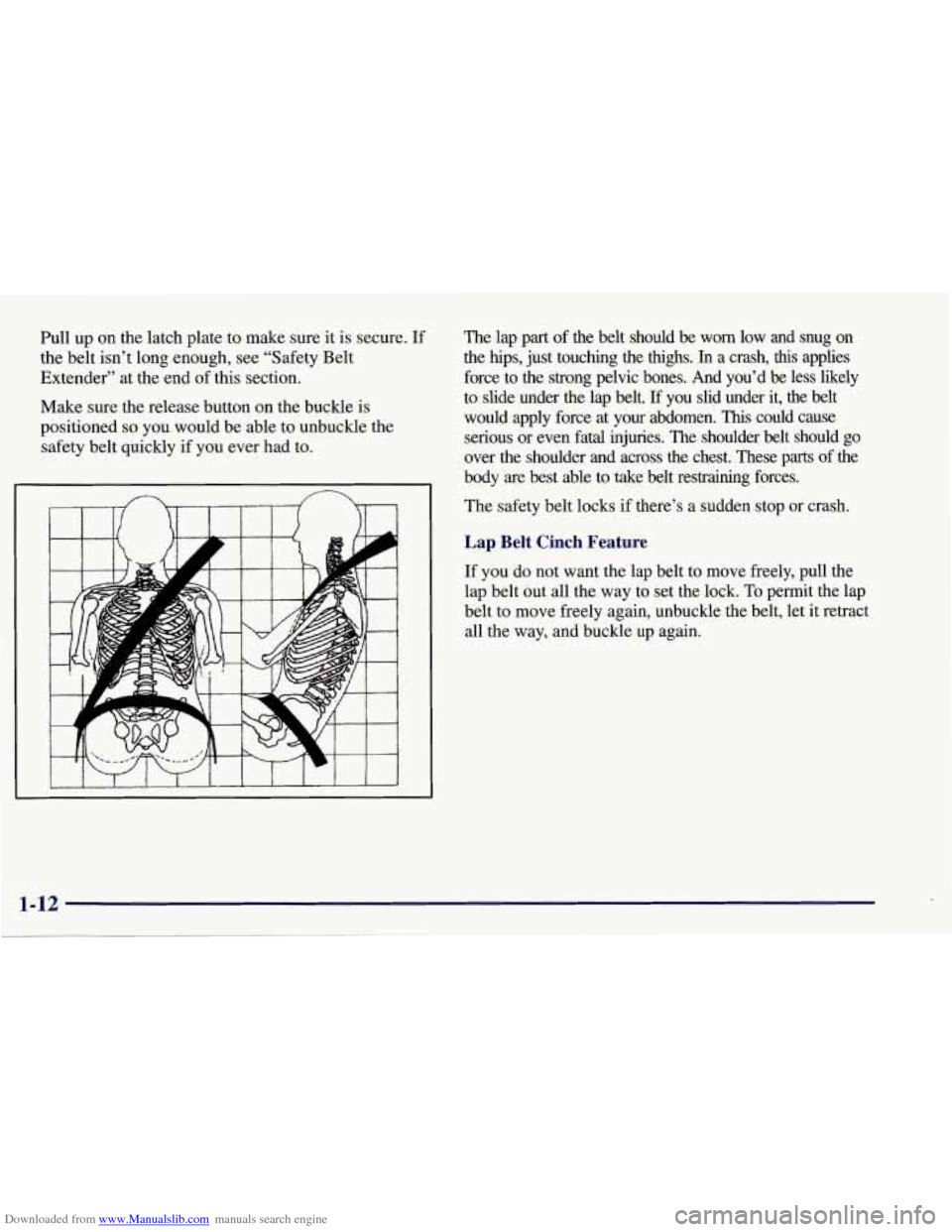
Downloaded from www.Manualslib.com manuals search engine Pull up on the latch plate to make sure it is secure. If
the belt isn’t long enough, see “Safety Belt
Extender” at the end of this section.
Make sure the release button on the buckle is
positioned
so you would be able to unbuckle the
safety belt quickly if you ever had to. The
lap part of the belt should be worn low
and snug on
the hips, just touching the thighs. In a crash, this applies
force to the strong pelvic bones. And you’d be less likely
to slide under the lap belt.
If you slid under it, the belt
would apply force at your abdomen.
This could cause
serious or even fatal injuries. The shoulder belt should go
over the shoulder and across the chest. These parts of the
body
are best able to take belt restraining forces.
The safety belt locks if there’s
a sudden stop or crash.
Lap Belt Cinch Feature
If you do not want the lap belt to move freely, pull the
lap belt out all the way to set the lock. To permit the lap
belt to move freely again, unbuckle the belt, let it retract
all the way, and buckle up again.
Page 34 of 378
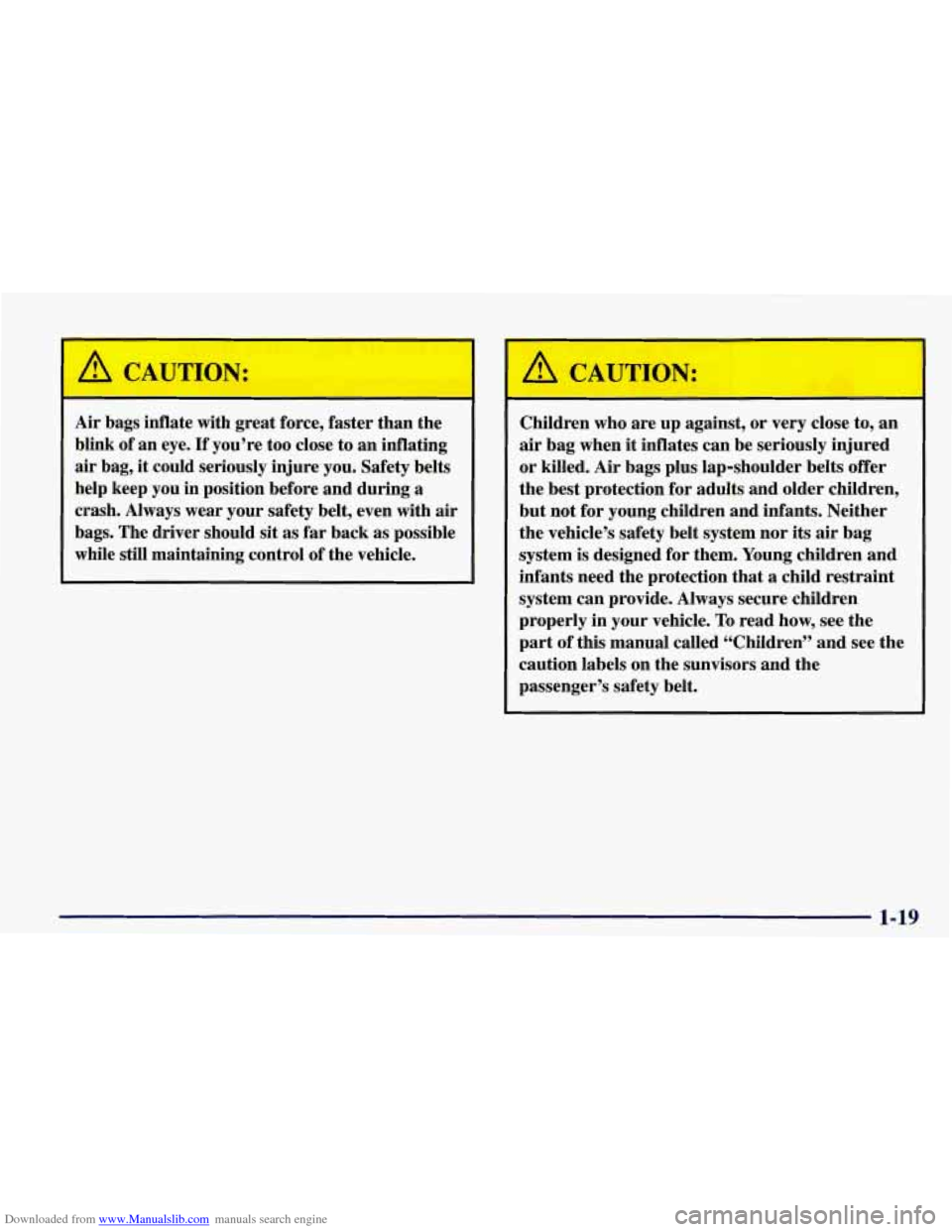
Downloaded from www.Manualslib.com manuals search engine Air bags inflate with great force, faster than the
blink of an eye.
If you’re too close to an inflating
air bag, it could seriously injure you. Safety belts
help keep you in position before and during a
crash. Always wear your safety belt, even with air
bags. The driver should
sit as far back as possible
while still maintaining control of the vehicle. Children
who are up against, or very close to, an
air bag when it inflates can be seriously injured
or killed.
Air bags plus lap-shoulder belts offer
the best protection for adults and older children,
but not for young children and infants. Neither
the vehicle’s safety belt system nor
its air bag
system
is designed for them. Young children and
infants need the protection that a child restraint
system can provide. Always secure children
properly in your vehicle. To read how, see the
part of this manual called “Children” and see the
caution labels
on the sunvisors and the
passenger’s safety belt.
1-19
Page 40 of 378
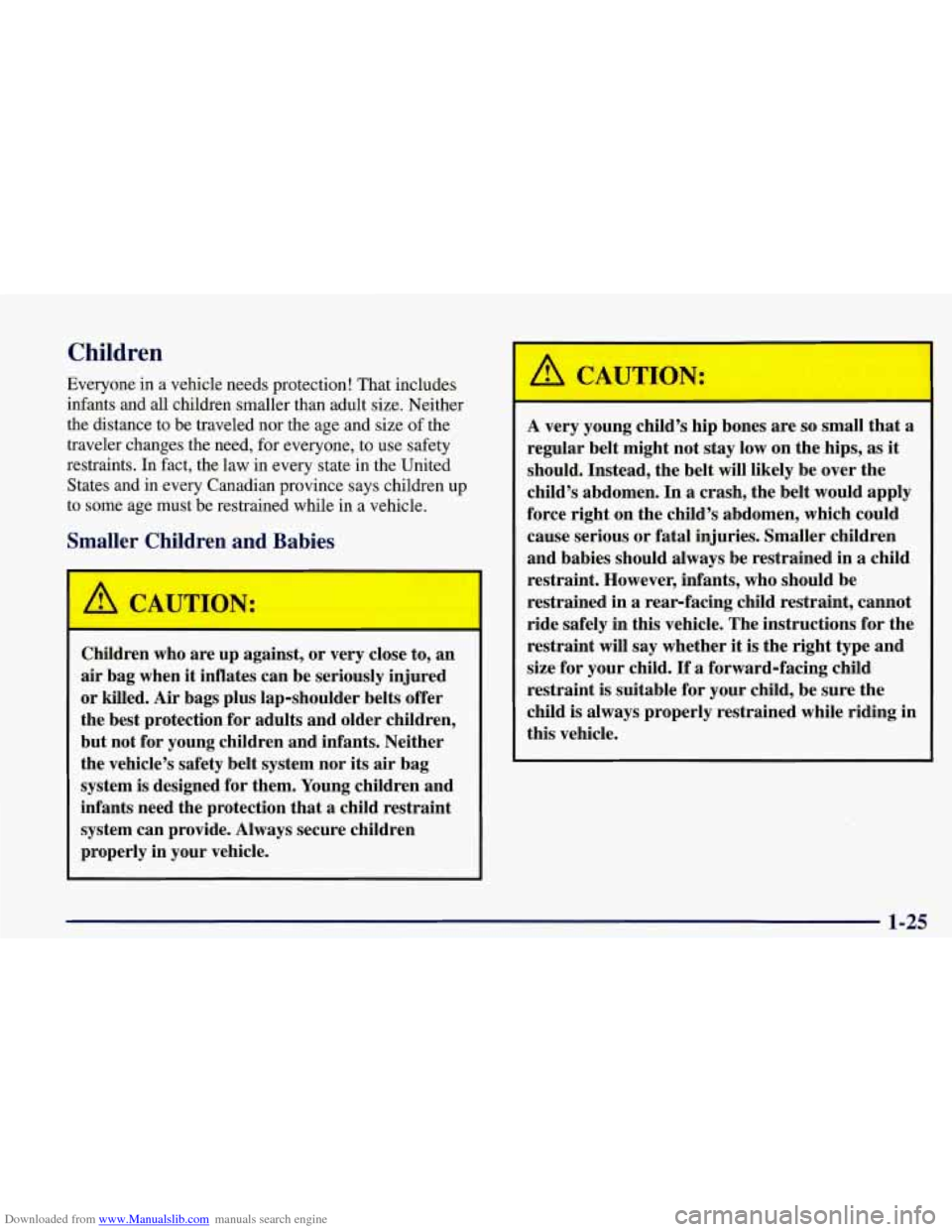
Downloaded from www.Manualslib.com manuals search engine I Children
Everyone in a vehicle needs protection! That includes
infants and all children smaller than adult size. Neither
the distance to be traveled nor the age and size of the
traveler changes the need, for everyone, to use safety
restraints.
In fact, the law in every state in the United
States and in
every Canadian province says children up
to some age must be restrained while in a vehicle.
Smaller Children and Babies
Children who are up against, or very close to, an
air bag when
it inflates can be seriously injured
or killed.
Air bags plus lap-shoulder belts offer
the best protection for adults and older children,
but not for young children and infants. Neither
the vehicle’s safety belt system nor its air bag
system is designed for them. Young children and
infants need the protection that a child restraint
system can provide. Always secure children
properly in your vehicle.
A CAUTION:
A very young child’s hip bones are so small that a
regular belt might not stay low on the hips, as it
should. Instead, the belt will likely be over the
child’s abdomen. In a crash, the belt would apply
force right on the child’s abdomen, which could
cause serious or fatal injuries. Smaller children
and babies should always be restrained in a child
restraint. However, infants, who should be
restrained in
a rear-facing child restraint, cannot
ride safely in this vehicle. The instructions for the
restraint will say whether it
is the right type and
size for your child.
If a forward-facing child
restraint is suitable for your child, be sure the
child is always properly restrained while riding in
this vehicle.
1-25
Page 41 of 378
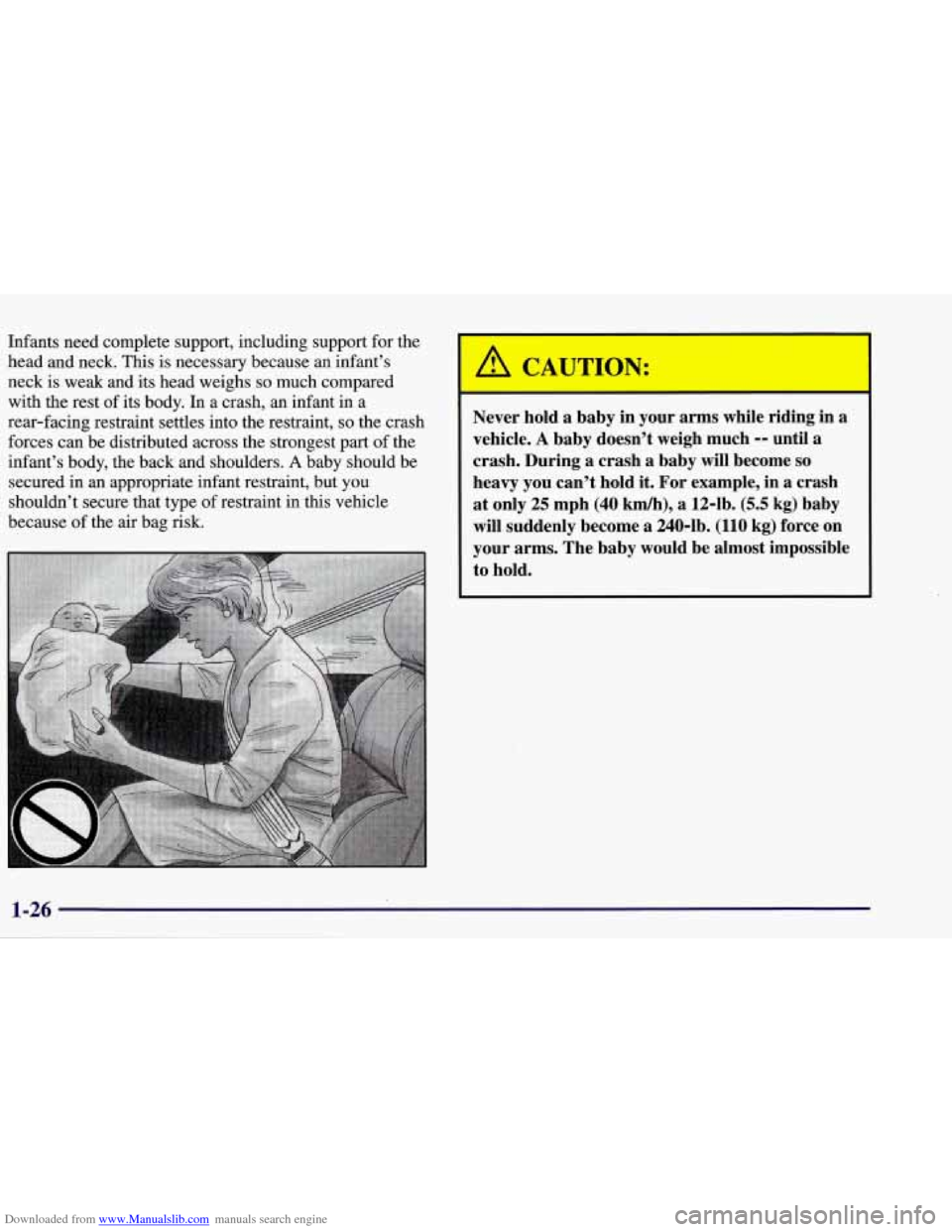
Downloaded from www.Manualslib.com manuals search engine Infants need complete support, including support for the
head and neck. This is necessary because an infant’s
neck is
weak and its head weighs so much compared
with the rest of its body.
In a crash, an infant in a
rear-facing restraint settles into the restraint, so the crash
forces can be distributed across the strongest part of the
infant’s body, the back and shoulders.
A baby should be
secured in
an appropriate infant restraint, but you
shouldn’t secure that type of restraint in this vehicle
because
of the air bag risk.
A CAUTION:
I
Never hold a baby in your arms while riding in a
vehicle.
A baby doesn’t weigh much -- until a
crash. During a crash a baby will become
so
heavy you can’t hold it. For example, in a crash
at only
25 mph (40 km/h), a 12-lb. (5.5 kg) baby
will suddenly become a 240-lb.
(110 kg) force on
your arms. The baby would be almost impossible
to hold.
Page 43 of 378
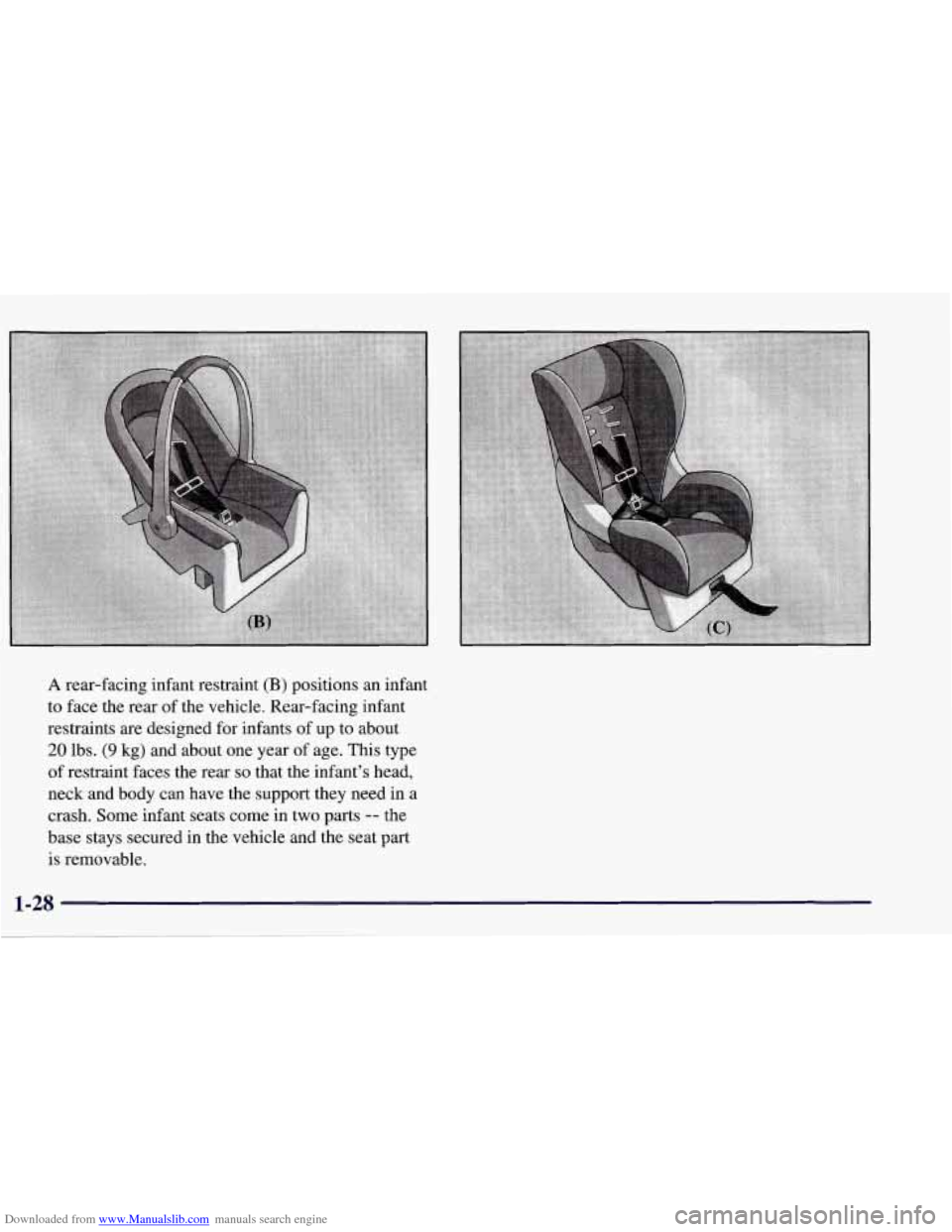
Downloaded from www.Manualslib.com manuals search engine A rear-facing infant restraint (B) positions an infant
to face the rear of the vehicle. Rear-facing infant
restraints are designed for infants of up to about
20 lbs. (9 kg) and about one year of age. This type
of restraint faces the rear
so that the infant’s head,
neck and body can have the support they need in a
crash. Some infant seats come in two parts
-- the
base stays secured in the vehicle and the seat part
is removable.
1-28
Page 46 of 378
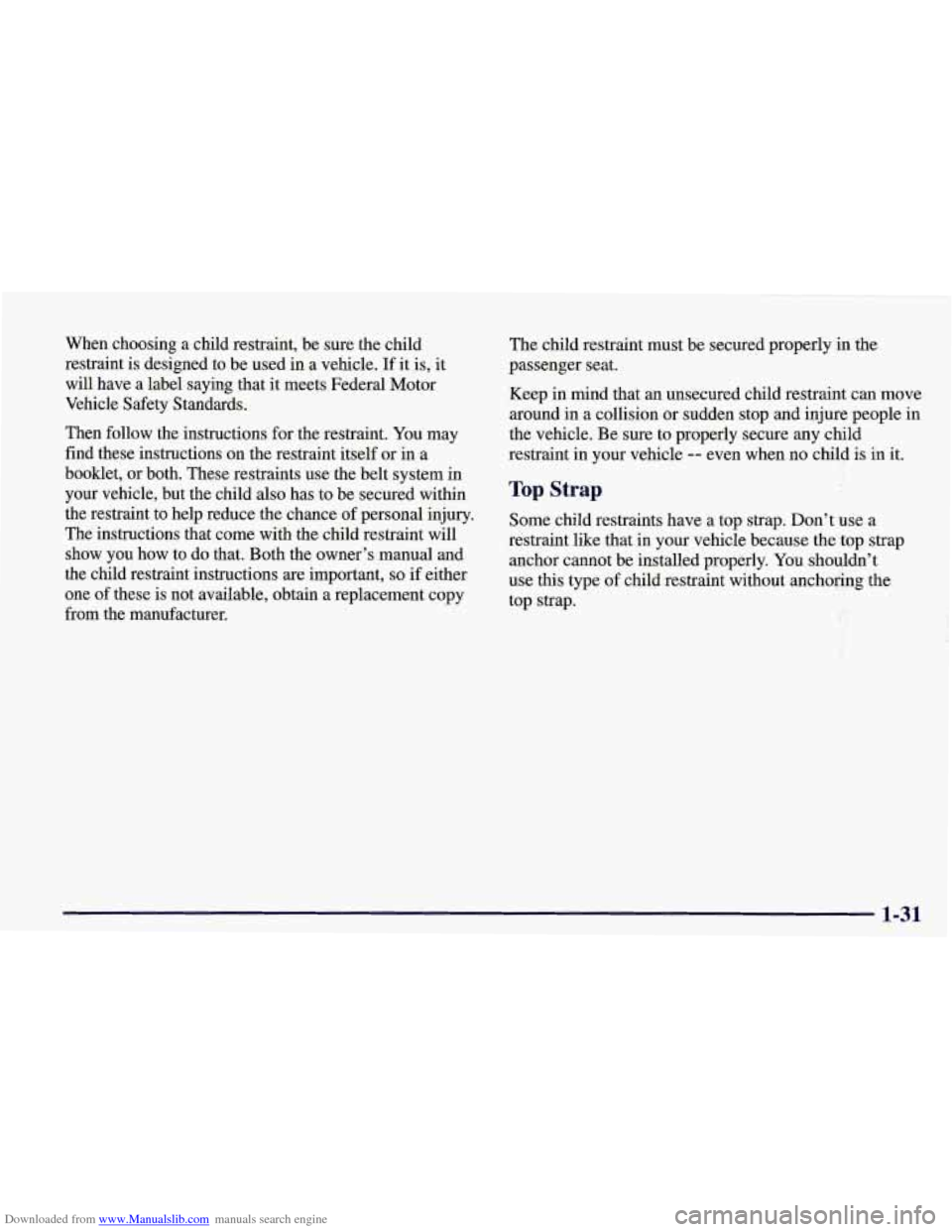
Downloaded from www.Manualslib.com manuals search engine When choosing a child restraint, be sure the child
restraint is designed to be used in a vehicle.
If it is, it
will have a label saying that it meets Federal Motor
Vehicle Safety Standards.
Then follow the instructions for the restraint. You may
find these instructions on the restraint itself or in a
booklet, or both. These restraints use the belt system in
your vehicle, but the child also has to be secured within
the restraint to help reduce the chance of personal injury.
The instructions that come with the child restraint will
show you how to do that. Both the owner’s manual and
the child restraint instructions are important,
so if either
one
of these is not available, obtain a replacement copy
from the manufacturer. The child restraint must be
secured properly in the
passenger seat.
Keep in mind that
an unsecured child restraint can move
around in a collision or sudden stop and injure people in
the vehicle. Be sure to properly secure any child
restraint in your vehicle
-- even when no child is in it.
Top Strap
Some child restraints have a top strap. Don’t use a
restraint like that in your vehicle because the top strap
anchor cannot be installed properly. You shouldn’t
use this type of child restraint without anchoring the
top strap.
1-31
Page 47 of 378
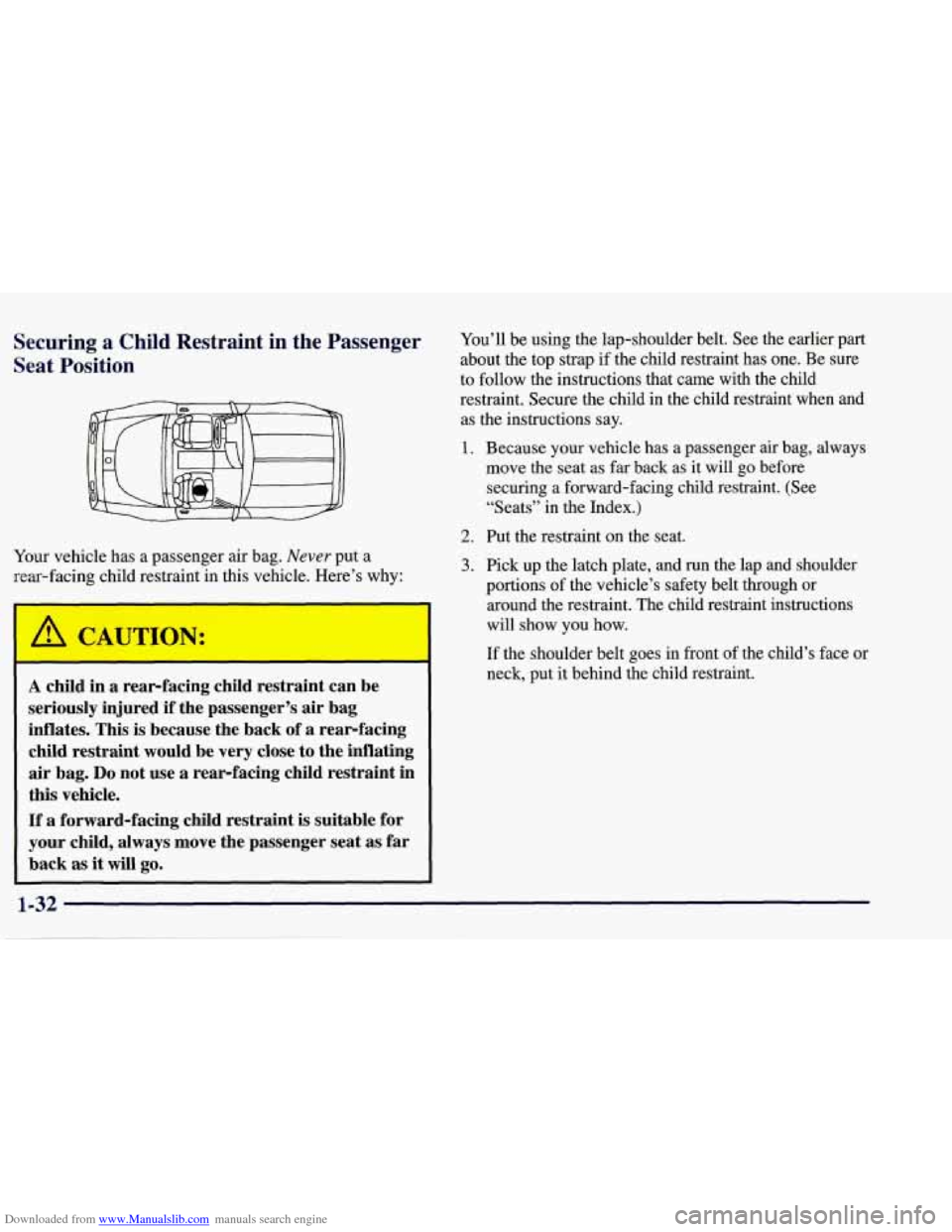
Downloaded from www.Manualslib.com manuals search engine Securing a Child Restraint in the Passenger
Seat Position
Your vehicle has a passenger air bag. Never put a
rear-facing child restraint in this vehicle. Here’s why:
A child in a rear-facing child restraint can be
seriously injured if the passenger’s air bag
inflates. This is because the back of a rear-facing
child restraint would be very close to the inflating
air bag.
Do not use a rear-facing child restraint in
this vehicle.
If’ a forward-facing child restraint is suitable for
your child, always move the passenger seat as far
back
as it will go.
You’ll be using the lap-shoulder belt. See the earlier part
about the top strap if the child restraint has one. Be sure
to follow the instructions that came with the child
restraint. Secure the child in the child restraint when and
as the instructions say.
1. Because your vehicle has a passenger air bag, always
move the seat as far back as it will go before
securing a forward-facing child restraint. (See
“Seats” in the Index.)
2. Put the restraint on the seat.
3. Pick up the latch plate, and run the lap and shoulder
portions of the vehicle’s safety belt through
or
around the restraint. The child restraint instructions
will show you how.
If the shoulder belt goes in front of the child’s face or
neck, put it behind the child restraint.
Page 49 of 378
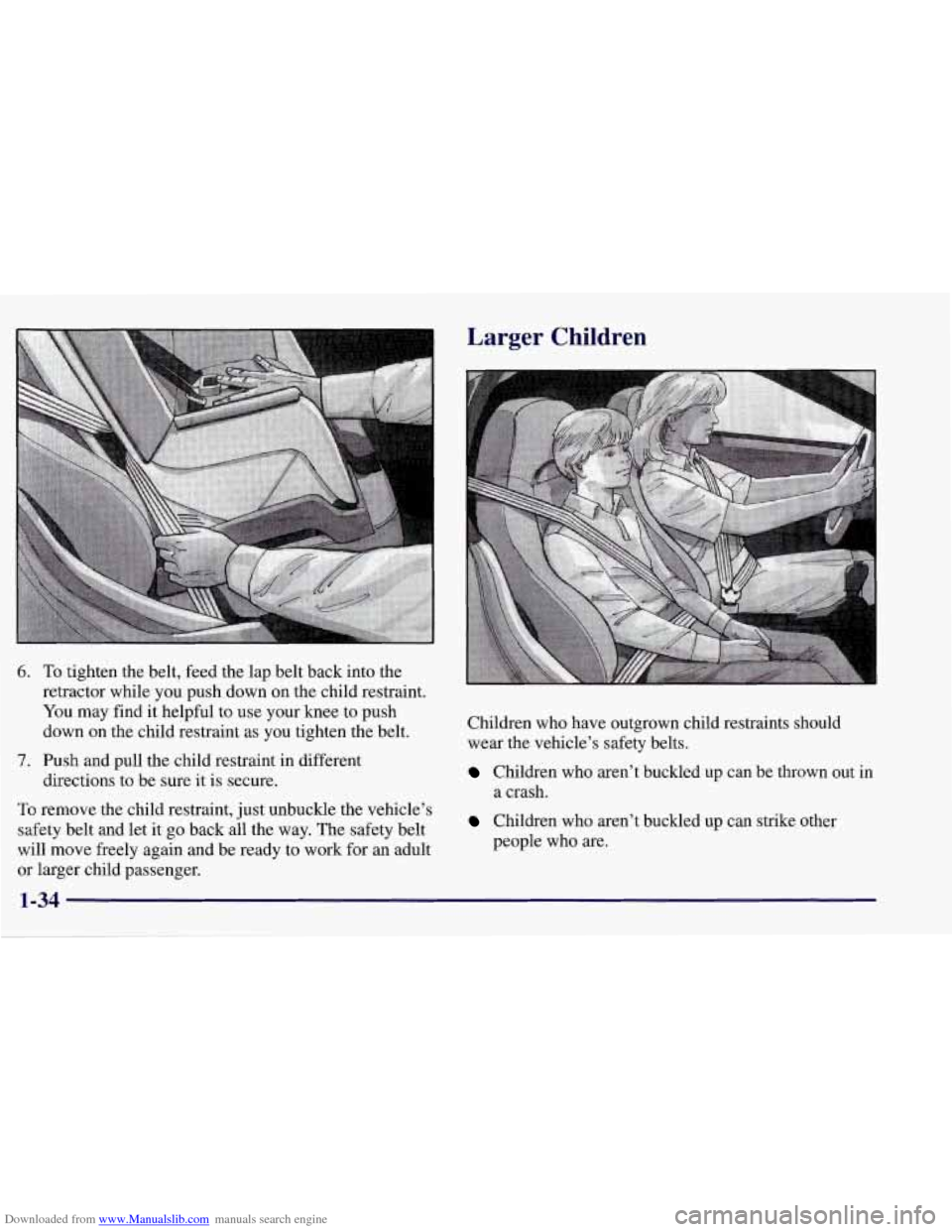
Downloaded from www.Manualslib.com manuals search engine 6.
7.
To tighten the belt, feed the lap belt back into the
retractor while you push down on the child restraint.
You may find it helpful to use your knee to push
down on the child restraint as you tighten the belt.
Push and pull the child restraint in different
directions to be sure it is secure.
To remove the child restraint, just unbuckle the vehicle's
safety belt and let it
go back all the way. The safety belt
will move freely again and be ready to work for an adult
or larger child passenger.
Larger Children
Children who have outgrown chld restraints should
wear the vehicle's safety belts.
Children who aren't buckled up can be thrown out in
a crash.
Children who aren't buckled up can strike other
people who are.
1-34
Page 64 of 378
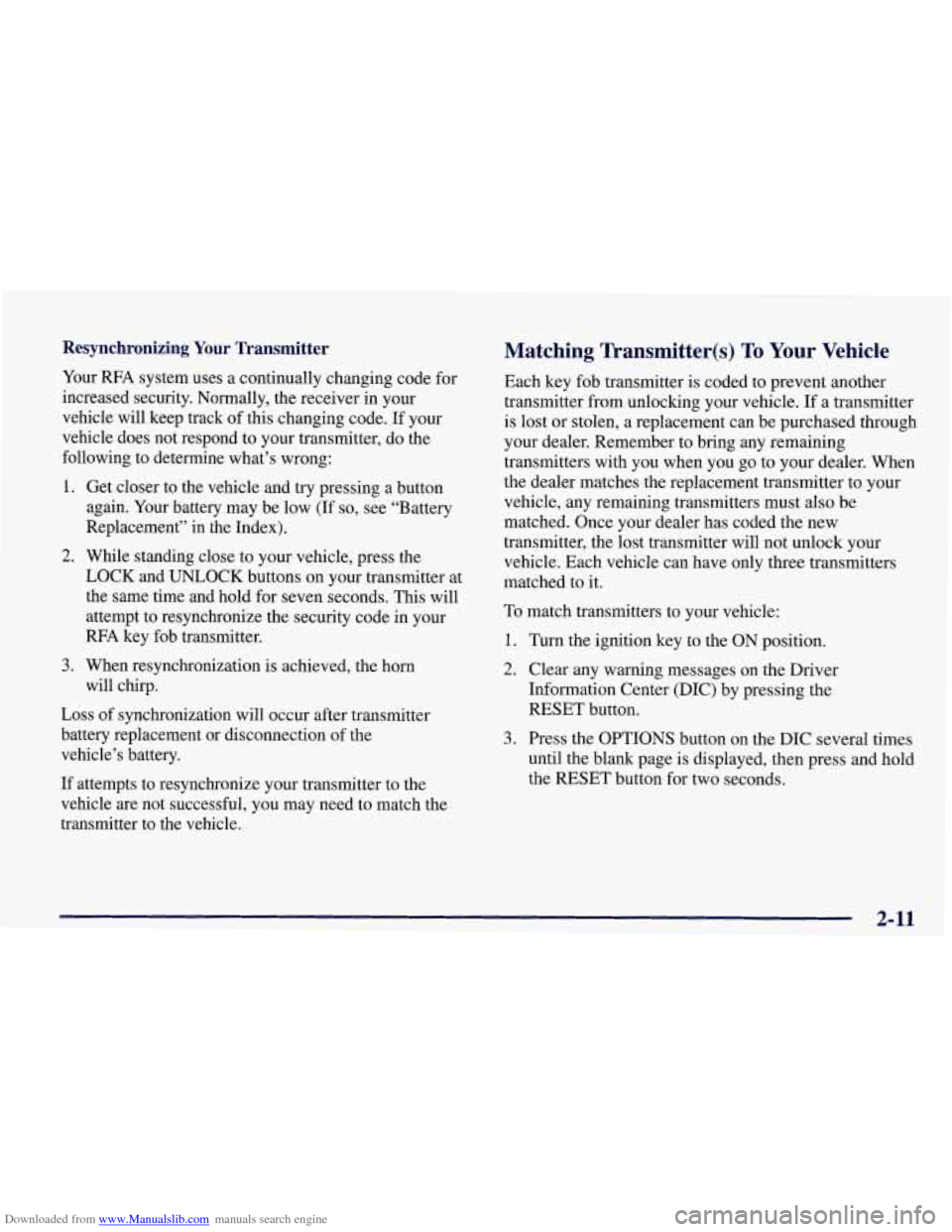
Downloaded from www.Manualslib.com manuals search engine Resynchronizing Your Transmitter
Your RFA system uses a continually changing code for
increased security. Normally, the receiver in your
vehicle will keep track of this changing code.
,If your
vehicle does not respond to your transmitter, do the
following to determine what’s wrong:
1. Get closer to the vehicle and try pressing a button
again. Your battery may be low (If
so, see “Battery
Replacement” in the Index).
2. While standing close to your vehicle, press the
LOCK and UNLOCK buttons on your transmitter at
the same time and hold
for seven seconds. This will
attempt to resynchronize
the security code in your
RFA key fob transmitter.
3. When resynchronization is achieved, the horn
will chirp.
Loss of synchronization will occur after transmitter
battery replacement or disconnection of the
vehicle’s battery.
If attempts to resynchronize your transmitter to the
vehicle are not successful, you may need
to match the
transmitter to the vehicle.
Matching Transmitter(s) To Your Vehicle
Each key fob transmitter is coded to prevent another
transmitter from unlocking your vehicle.
If a transmitter
is lost or stolen,
a replacement can be purchased through
your dealer. Remember to bring any remaining
transmitters with you when you go to your dealer. When
the dealer matches the replacement transmitter to your
vehicle, any remaining transmitters must also be
matched. Once your dealer has coded the new
transmitter, the lost transmitter will not unlock your
vehicle. Each vehicle can have only three transmitters
matched to it.
To match transmitters to your vehicle:
1. Turn the ignition key to the ON position.
2. Clear any warning messages on the Driver
Information Center (DIC) by pressing the
RESET button.
3. Press the OPTIONS button on the DIC several times
until the blank page is displayed, then press and hold
the RESET button for two seconds.
2-11
Page 70 of 378
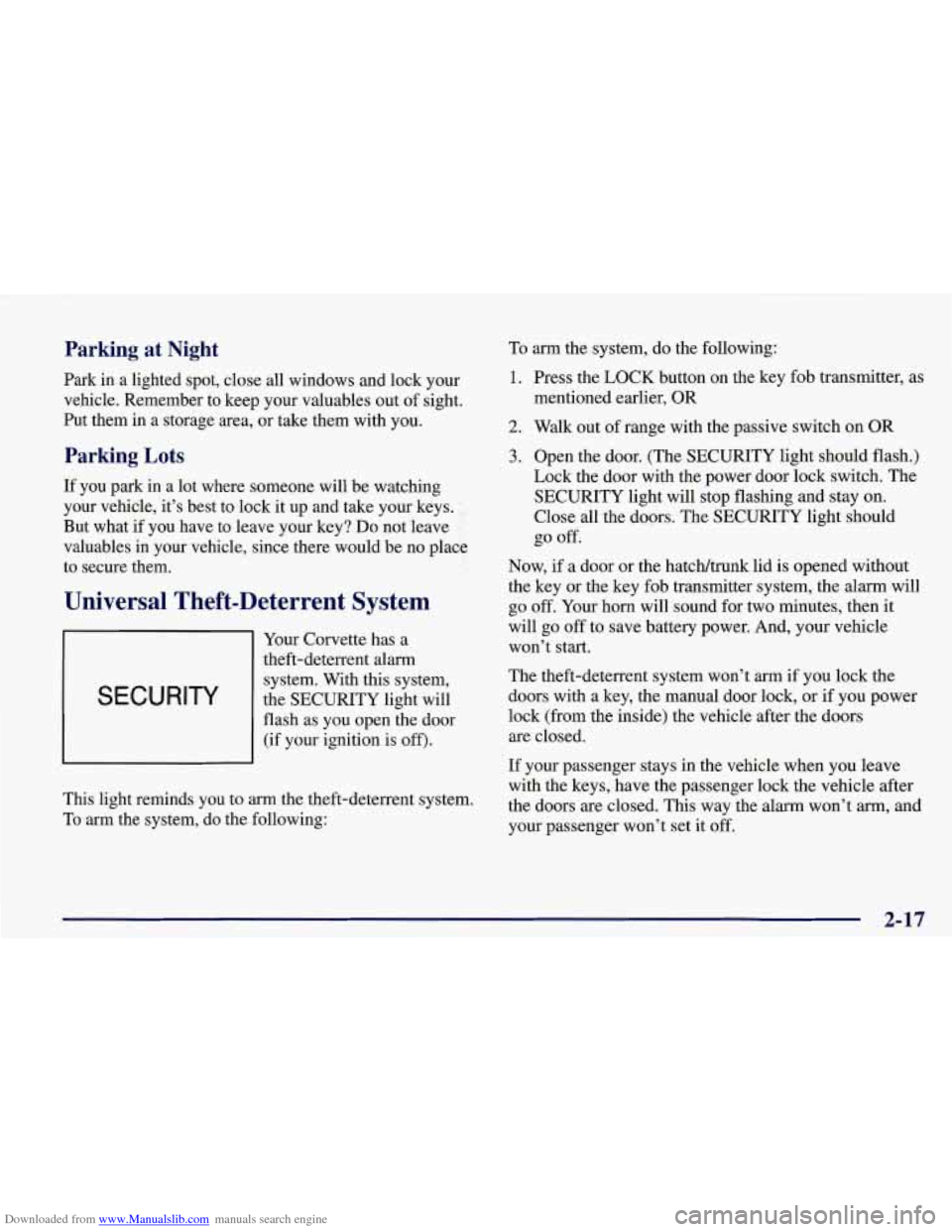
Downloaded from www.Manualslib.com manuals search engine Parking at Night
Park in a lighted spot, close all windows and lock your
vehicle. Remember to keep your valuables out of sight.
Put them in a storage area, or take them with you.
Parking Lots
If you park in a lot where someone will be watching
your vehicle, it’s best to lock
it up and take your keys.
But what if you have to leave your key?
Do not leave
valuables in your vehicle, since there would be no place
to secure them.
”<
Universal Theft-Deterrent System
Your Corvette has a
theft-deterrent alarm
I SECURITY
system. With this system,
the SECURITY light will
flash as you open the door (if your ignition is
off).
This light reminds you to arrn the theft-deterrent system.
To arm the system, do the following: To
arm the system, do the following:
1. Press the LOCK button on the key fob transmitter, as
mentioned earlier, OR
2. Walk out of range with the passive switch on OR
3. Open the door. (The SECURITY light should flash.)
Lock the door with the power door lock switch. The
SECURITY light will stop flashing and stay on.
Close all the doors. The SECURITY light should
go off.
Now,
if a door or the hatcWtmnk lid is opened without
the key or the key fob transmitter system, the alarm will
go
off. Your horn will sound for two minutes, then it
will go off to save battery power. And, your vehicle
won’t start.
The theft-deterrent system won’t arm
if you lock the
doors with a key, the manual door
lock, or if you power
lock (from the inside) the vehicle after the doors
are closed.
If your passenger stays in the vehicle when you leave
with the keys, have the passenger lock the vehicle after
the doors are closed. This way the alarm won’t
arm, and
your passenger won’t set it
off.
2- 17